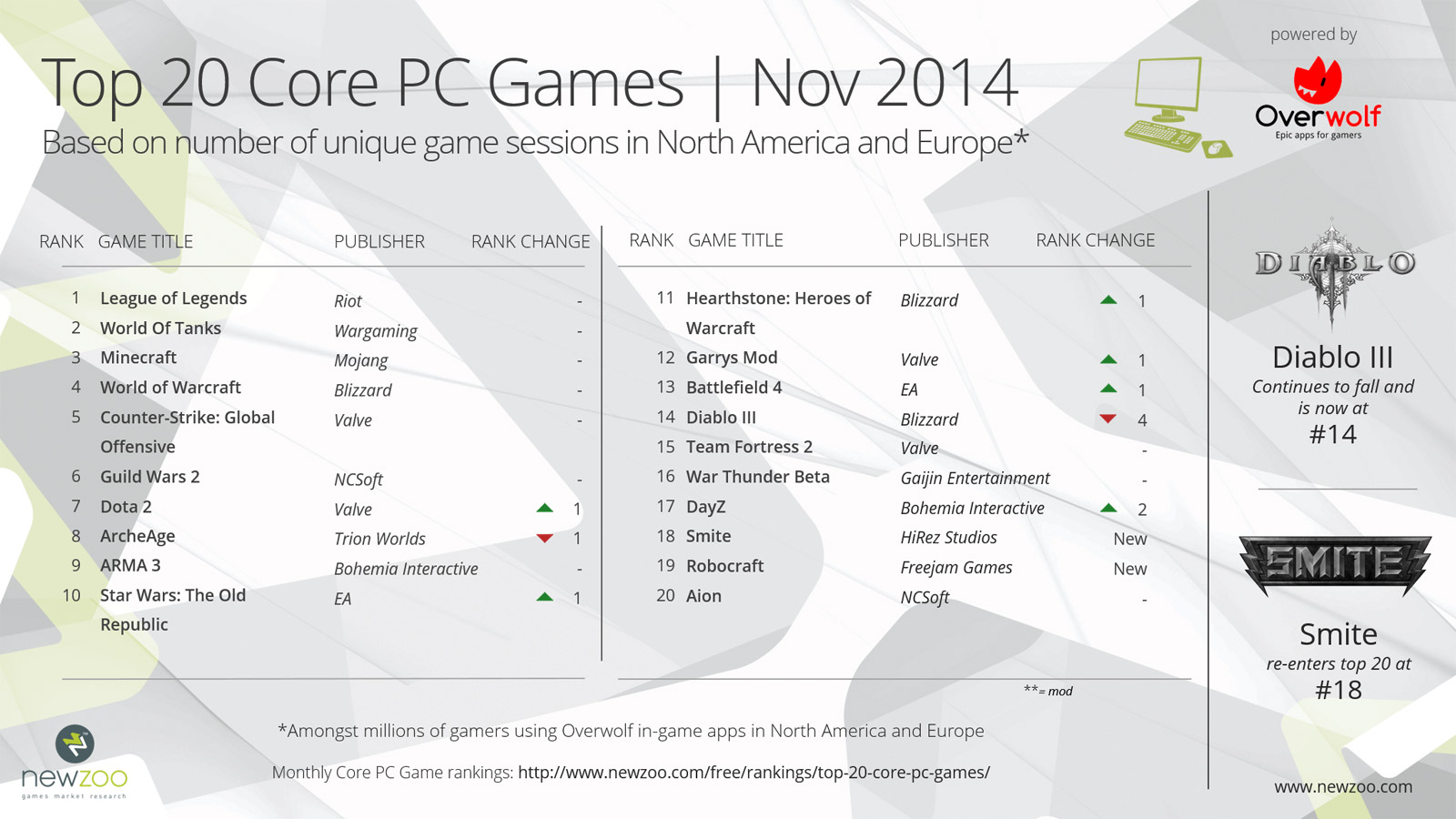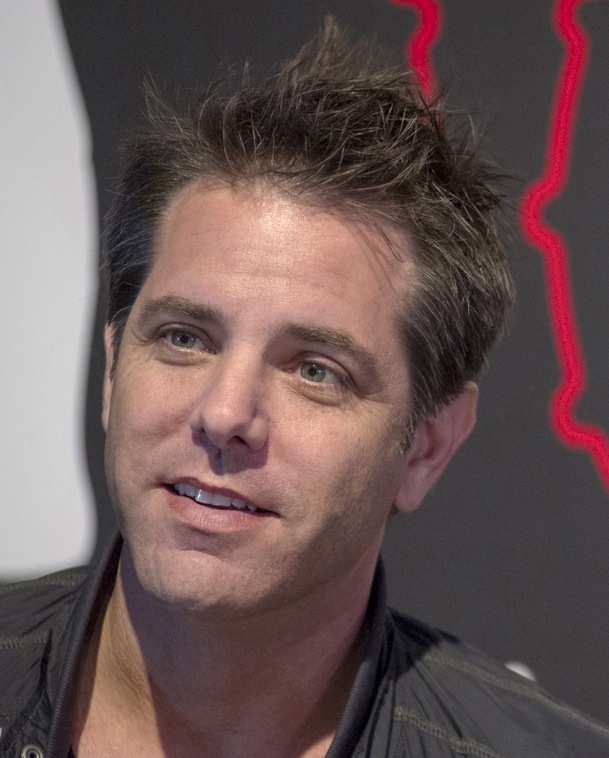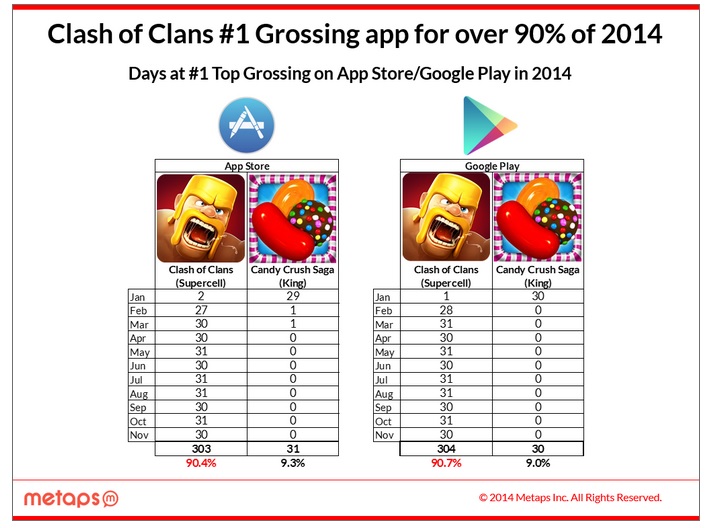On the surface the Top 20 Core PC Game Ranking looks deceptively calm in November, doubly so at the top. League of Legends, World of Tanks and Minecraft continue to dominate the top three spots, with World of Tanks maintaining its number 2 spot for the second month in a row. Further examination reveals the critical impact that upcoming releases and the eSports craze can have on unique game sessions.
It’s a Riot
It’s an interesting time for League of Legends, accounting for 18 percent of all the unique play time sessions in the time period, down from the 20 percent it achieved in the previous month. This small decline is to be expected as the game is now technically in “pre-season,” with zero ladder rank play for gamers, until the start of the new season in January 2015. With a lower incentive for competitive play, we’d expect LoL’s capture of session time to decline until rank play reopens next year. Riot Games recently shared the viewer statistics for this year’s League of Legends World Championship’s final in South Korea. Overall unique viewers totaled 27 million, marking a slight decline by last year’s 32 million. However concurrent viewer numbers peaked at 11.2 million, a fair increase over the 8.7 million achieved in 2013. These numbers are made doubly significant considering the finals were live broadcast between 4-8 a.m. in North America — a generally unfavorable timeslot.
Tank Sports
Wargaming’s World of Tanks continues to accelerate its commitment to eSports, starting with its Stronghold 9.2 update and its most recent 9.4 update that emphasizes clan wars and team work. More importantly the most serious problem with World of Tanks’ eSports ambitions have been addressed: 2015 matches will no longer end in draws with the creation of a new Attack and Defense format. It will be interesting to see how overall session times are affected once the new season begins with these long awaited changes finally in operation.

Expansion Highs
Moving down the rankings we see Blizzard’s World of Warcraft holding steady at rank 4, with Hearthstone moving up one place to Rank 11. The two titles have been the focus of significant interest in the past month with the Nov 13 release of the World of Warcraft: Warlords of Draenor expansion and the upcoming release of Hearthstone: Goblins vs. Gnomes on December 8. The WoW expansion saw the largest increase of subscriber numbers for the title in many a year, increasing by 3 million to just over 10 million subscribers, proving that for select titles the subscription model can still be viable.
However, Blizzard’s remaining title on the rankings Diablo III has been on a bit of a freefall. Falling two places to Rank 10 in October, the title has dropped an additional four places in November to land at Rank 14. Part of this decline could be attributed to the delay of the Ruins of Sescheron content patch that has been eagerly awaited by fans since its announcement at BlizzCon 2014. The title itself is in an interesting position considering it is currently the only Blizzard IP without a full expansion announced. This is in addition to the unveiling of the brand new Blizzard IP Overwatch, a title that seems directly aimed at the casual FPS competitive space.
EA’s Star Wars: The Old Republic increased by one place to Rank 10, driven by the imminent release of the Shadows of Revan expansion in December.
The New and Not So New
HiRez Studio’s Smite, having been conspicuously absent from the rankings in some time, has returned to take Rank 18. The likely reason is the increasing traction the title has received in the eSports arena, empowered by a recent large investment from Tencent and its forthcoming release on the Xbox platform. The title’s first World Championship will be taking place in Atlanta in January 2015, with a community sponsored prize poll that is already over 1.6 million dollars.
The other new entry is Freedom Games’ Robocraft, a PvP game where players design and build robots to competitively battle each other. Described as a sci-fi Minecraft with guns, the title is F2P, has overwhelmingly positive reviews on Steam, and currently sits at number 4 on IndieDB. Despite the small development team and limited media coverage, the title is a perfect example of the effect community driven interest for new and exciting game types has on the overall PC market.
Find more information on the eSports market and audience here.
About Overwolf
Overwolf is a customizable in-game overlay platform that has been installed in over 8 million PCs. This community of hardcore PC gamers are consistently making their own apps within the Overwolf platform and sharing them. Why Because it’s super simple and it enhances the gameplay experience of anyone’s favorite title in a personal way. From in-game chat systems to customized controls, streaming or video capture, Overwolf allows users to implement their own visions into these games and do so in a timely manner.
About Newzoo
Newzoo is the leading global market research firm focused purely on the games market. The company provides its clients with a mix of primary consumer research, transactional data and financial analysis across all continents, screens and business models. It is also known for actively sharing a variety of insights by means of free trend reports, infographics, blogposts and monthly rankings. Newzoo’s clients include Tencent, SEGA, Logitech, Wizards of the Coast, Nvidia, Microsoft, EA, Coca-Cola and Visa/PlaySpan.

 Matt Wolf, Head of Global Gaming at Coca-Cola
Matt Wolf, Head of Global Gaming at Coca-Cola

